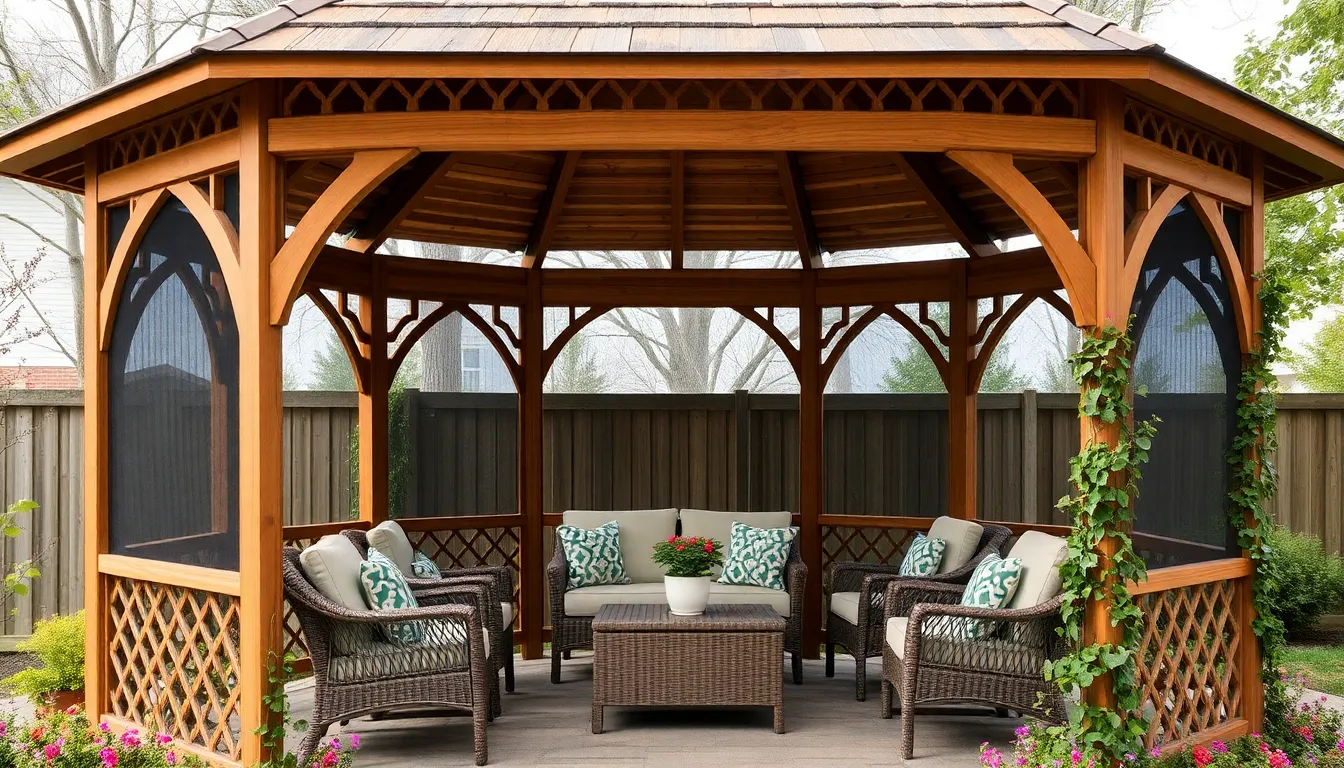Imagine transforming your backyard into a haven of relaxation and style with a stunning DIY gazebo! Whether you’re a first-time DIY enthusiast or a seasoned outdoor project pro, this guide offers ten inspirational ideas that cater to every skill level. With creativity and a touch of elbow grease, you can create an inviting space that captures the essence of outdoor living at its best.
Dive into these beautiful gazebo concepts and discover the joy of building a space that not only enhances your home’s aesthetic but also boosts its functionality. From quaint hideaways to grand statement pieces, each idea promises practical benefits like increased outdoor enjoyment and home value. Get ready to feel empowered and excited as you embark on a journey to transform your outdoor area into a personal paradise.
Choose Sustainable Building Materials

Opting for sustainable building materials in your gazebo project can significantly reduce environmental impact while adding unique charm to your backyard space. Consider using reclaimed wood, which not only provides a rustic aesthetic but also helps reduce waste. Additionally, bamboo is a fast-growing and renewable material that’s both lightweight and durable, making it an excellent choice for a gazebo roof or decorative elements. For those looking to incorporate eco-friendly options, recycled metal or composite materials can offer strength and longevity without compromising on style.
Beyond material selection, focus on design elements that enhance sustainability and functionality. Plan your gazebo to maximize natural light by incorporating open sides or strategically placed skylights, which will reduce the need for artificial lighting during the day. To further improve sustainability, consider installing a rainwater collection system integrated into your gazebo’s roof design. This can provide a renewable water source for garden irrigation. For an advanced touch, adding solar-powered lights will keep your gazebo bright and inviting after dark while remaining energy-efficient.
Incorporate Natural Ventilation Features

Incorporating natural ventilation features into your gazebo design is essential for maintaining comfort and airflow. Start by considering the orientation of your gazebo; placing it where it can catch prevailing breezes will naturally cool the space. For effective air circulation, use lattice panels or open-weave materials on the gazebo’s sides. These materials allow air to flow freely while still providing shade and privacy. Beginners can easily install these panels using basic tools, while more advanced DIYers might even design adjustable panels to optimize airflow.
Another effective strategy is to include a cupola or vented roof in your gazebo design. This feature allows hot air to escape, drawing cooler air in from the sides. Ensure the vent is large enough to be effective but proportionate to your gazebo’s size; a diameter of at least 12 inches is a good starting point for most structures. For those with more experience, consider adding a solar-powered fan to enhance ventilation, especially in larger gazebos. By integrating these features, you ensure a comfortable, breezy environment perfect for summer relaxation.
Add Built-In Seating Options

Adding built-in seating options to your gazebo can enhance both its functionality and aesthetic appeal. Consider using durable materials like cedar or teak, which are resistant to weather and insects, ensuring long-lasting seating. For a basic setup, integrate benches along the perimeter of the gazebo. These can be simple wooden planks supported by sturdy legs or attached directly to the gazebo frame. Beginners can start with pre-cut wood and basic tools, while more experienced DIYers might opt for custom designs with added storage beneath the seats.
For a more advanced touch, incorporate cushions and upholstery made from weather-resistant fabrics like Sunbrella, which offer comfort and withstand outdoor conditions. Custom-fit cushions can be crafted to match your gazebo’s design, adding a layer of personalized style. Consider including built-in planters at the ends of the benches for integrated greenery, enhancing the space’s natural vibe. Ensure the seating height is comfortable, typically around 18 inches, and the depth is adequate for relaxed seating, generally between 18-24 inches. These thoughtful additions will transform your gazebo into a cozy retreat.
Utilize Space-Saving Design Techniques

Maximizing the use of space in your gazebo can transform a small area into a highly functional retreat. Consider multi-purpose furniture like benches with storage underneath or tables that fold away when not in use. These elements not only save space but also enhance the overall functionality of your gazebo. For a seamless look, use weather-resistant materials like treated wood or composite decking for furniture, ensuring durability while maintaining aesthetic appeal.
To further optimize your gazebo’s footprint, think vertically. Incorporate vertical planters or hanging gardens that add greenery without taking up precious floor space. Utilize lightweight lattice panels or trellises to support climbing plants or to hang decorative elements, creating a lush, inviting environment. Advanced gardeners might try integrating retractable shelves or modular walls that can be adjusted depending on the occasion, offering flexibility and sophistication to your backyard haven.
Create Multi-Functional Roof Structures

Integrating multi-functional roof structures into your gazebo design can maximize both utility and aesthetics. Consider using transparent polycarbonate panels for a modern touch, allowing light to filter through while providing protection from the elements. For those seeking versatility, installing adjustable louvered roofs can offer the flexibility to control sunlight and ventilation, adapting to your needs throughout the day.
For a more traditional approach, a simple timber-framed roof with climbing plants like wisteria or grapevines can create a lush, natural canopy. Beginners might start with treated pine or cedar for durability, while more advanced builders could explore integrating solar panels into the design.
- Ensure adequate support by measuring and reinforcing beams properly, especially if adding weight like plants or panels.
- Utilize rust-resistant hardware to withstand outdoor conditions.
By thoughtfully choosing materials and design elements, your gazebo’s roof can become a multifunctional feature that enhances your outdoor living space.
Enhance Privacy with Lattice Walls

Incorporating lattice walls into your gazebo design is an excellent way to enhance privacy while adding an elegant touch. Select durable materials such as cedar or pressure-treated wood for longevity and resistance to weather conditions. For a beginner-friendly project, consider a simple square or diamond pattern, which provides both privacy and airflow. You can customize the dimensions of the lattice to fit your space, but a standard 4×8-foot panel is a versatile choice that can be easily cut to size.
For more advanced DIYers, try adding a climbing plant like wisteria or jasmine to your lattice walls for a natural, lush screen. Ensure the lattice is securely anchored with sturdy posts, spaced about 6 to 8 feet apart, to support the weight of the plants as they grow. This setup not only offers a secluded retreat but also introduces a dynamic aesthetic with seasonal blooms and greenery. Remember, proper maintenance of the lattice and plants will keep your gazebo looking beautiful year-round.
Integrate Low-Maintenance Plantings

To create a lush and inviting atmosphere around your gazebo, consider integrating low-maintenance plantings. Choose hardy perennials like lavender, hostas, or ornamental grasses, which require minimal care but add a touch of elegance. Focus on drought-tolerant species if you live in a dry climate, as these plants will thrive with less water, reducing your garden maintenance efforts.
Incorporate plants with varying heights and textures to add depth and interest to your gazebo area. Use taller plants like coneflowers or hydrangeas at the back and shorter ground covers such as creeping thyme or sedum in the foreground. For an advanced touch, create a layered planting scheme by mixing evergreen shrubs with seasonal blooms, ensuring year-round beauty and appeal.
Install Solar-Powered Lighting Systems

To enhance your gazebo’s functionality and ambiance, consider installing a solar-powered lighting system. These systems are not only eco-friendly but also cost-effective, as they harness sunlight to power your lights at night. Begin by selecting solar lights that are specifically designed for outdoor use, ensuring they are weather-resistant and durable. Look for LED options, which are energy-efficient and provide bright illumination. Position lights along pathways, around the gazebo’s perimeter, or on the roof to create a warm, inviting glow.
For a seamless installation, use mounting brackets or stakes to secure the solar panels in a location that receives ample sunlight during the day. Opt for adjustable panels to maximize sun exposure and efficiency. Advanced users might explore integrating a solar-powered string light system, which can be artfully draped around the gazebo’s interior for a festive touch. Always follow the manufacturer’s instructions for the best placement and operation, and remember to regularly clean the panels to maintain optimal performance.
Opt for Weather-Resistant Fabric Covers

When designing a DIY gazebo, opting for weather-resistant fabric covers can significantly enhance both its durability and aesthetic appeal. Choose materials like polyester or acrylic, which are specifically treated to withstand UV rays, rain, and wind, ensuring your outdoor space remains a cozy retreat all year round. For added protection and style, consider double-stitched seams and reinforced eyelets that will help your cover endure the elements while maintaining a sleek look.
Advanced DIY enthusiasts may want to explore the use of tensioned fabric structures, which provide both strength and elegance to your gazebo. For a beginner-friendly approach, simple hooks or Velcro straps can efficiently secure the fabric to your gazebo frame. Consider incorporating additional elements such as pergola curtains or mosquito netting to maximize comfort and functionality. By carefully selecting and installing these materials, you can create a long-lasting, inviting outdoor haven.
Include Modular Furniture Arrangements

Transform your gazebo into a versatile outdoor living space by incorporating modular furniture arrangements. Opt for lightweight, weather-resistant materials like aluminum frames with removable cushions made from outdoor-grade fabrics. This allows you to easily rearrange pieces to suit your needs, whether you’re hosting a dinner party or enjoying a quiet afternoon with a book. Look for modular sets that include a combination of chairs, ottomans, and sectional sofas, providing flexibility and adaptability for any occasion.
Consider adding a low-maintenance, adjustable-height table that can double as a coffee table or dining surface. For a more personalized touch, mix and match different modules to create unique seating configurations that reflect your style and accommodate your space. Advanced gardeners might also integrate built-in planters within the furniture to seamlessly blend greenery with the seating area. This approach not only enhances the aesthetic appeal but also maximizes the functionality of your outdoor haven.
Conclusion: Creating Beautiful Outdoor Spaces
In exploring ’10 Beautiful DIY Gazebo Ideas for Your Backyard,’ we’ve uncovered how creating intimate spaces can enrich your relationship. From rustic wooden retreats to modern minimalist havens, each gazebo idea fosters a unique atmosphere where connections can deepen. Whether it’s sharing quiet morning coffees or hosting heartfelt evening conversations, these settings serve as the perfect backdrop for nurturing your bond.
Ready to transform these inspirations into reality? Start by selecting the gazebo style that resonates most with your relationship’s essence. Begin planning your project together, using it as an opportunity to collaborate and communicate, strengthening your partnership in the process.
To ensure these ideas remain at your fingertips, bookmark this article. As you work through your DIY project, you’ll have a handy reference for each step, ensuring that your vision comes to life seamlessly.
Remember, investing time and effort into creating shared spaces is an investment in your relationship’s future. By prioritizing these moments, you’re not just building a gazebo—you’re crafting a foundation for lasting love and connection. Take the first step today, and watch your relationship flourish in the haven you’ve created together.


